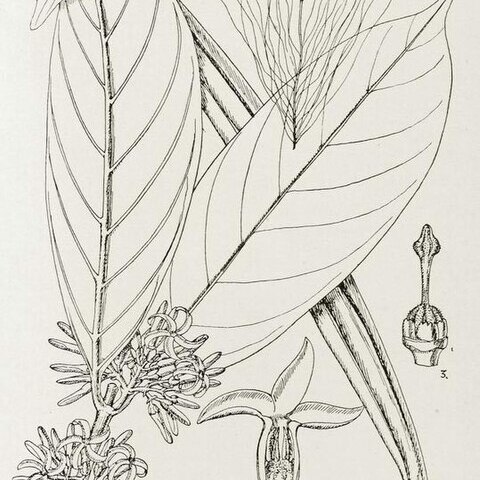Corolla tube very pale green to creamy, almost cylindrical, ventricose at 2/5–4/5 from the base, 1·7–5 times as long as the calyx, 5·8–10 x 2·5–5 mm., glabrous to puberulous outside; lobes creamy, recurved, 0·5–1·6 times as long as the tube, obliquely ovate to narrowly oblong, 1–5·5 times as long as wide, 5–15 x 2–5 mm., obtuse or acute, glabrous to puberulous on both sides, sometimes pubescent inside near the base.
Leaves petiolate; petiole 0·3–1·5 cm. long, glabrous or minutely pubescent; lamina subcoriaceous to coriaceous, 1·5–4 times as long as wide, 5–32 x 1·7–17 cm., often puberulous on the midrib; secondary veins 6–13, mostly parallel; domatia consisting of a tuft of straight hairs, varying in density, sometimes absent; margin slightly undulate and somewhat revolute.
Pistil 4–7 mm. long; ovary almost cylindrical to subglobose, 1·2–2 x 0·9–2 mm., pubescent at the apex, style 1·2–3 x 0·2–0·35 mm., glabrous or with a few erect hairs; clavuncula and stigma 0·9–2·4 x 0·3–1·1 mm.
Stamens 1·1–4·5 x 0·6—1·5 mm., inserted at 2/5–4/5 from the base of the tube; anthers 1–4·5 x 0·6–1·5 mm. with a 1·1–2·2 mm. long fertile portion; connective dorsally appressed pubescent.
Inflorescence 3–40-flowered, 2–2·5 x 1·5–4·5 x 1·5–4·5 cm.; pedicels 3–15 mm. long, glabrous or puberulous; bracts obtuse or acute, 0·9–2 mm. long with colleters in the axils.
Sepals triangular to broadly ovate, l·5–4x 1·8–3 mm., glabrous or puberulous outside; colleters, 5–50 varying in both shape and size, even in a single flower.
Fruit a follicle 8·4–32 cm. long, almost fusiform, 1·4–5·1 cm. in circumference and with the flat adaxial side 0·6–3·6 cm. wide.
A tree. It grows 30 m tall. The leaves are 10-20 cm long. The fruit are in pairs and 9-15 cm long.
Disk 5-lobed; lobes 0·4–1·6 mm. long, shorter than or rarely as long as the ovary.
Mature buds cylindrical to slightly conical, 8·5–22 mm. long, obtuse to subacute.
Seed 3·5–-7·5 x 0·2–0·6 cm.; rostrum 1·6–6 cm. long with 3·2–-9 cm. long hairs.
A glabrous tree, frequently about 30 ft. high but sometimes up to 100 ft.
Trunk up to 50 cm. in diam.; branchlets glabrous or minutely pubescent.
Corolla fleshy, yellowish-to greenish-white or orange.
Tree or shrub, up to 30 m. high.
The flowers in axillary clusters


